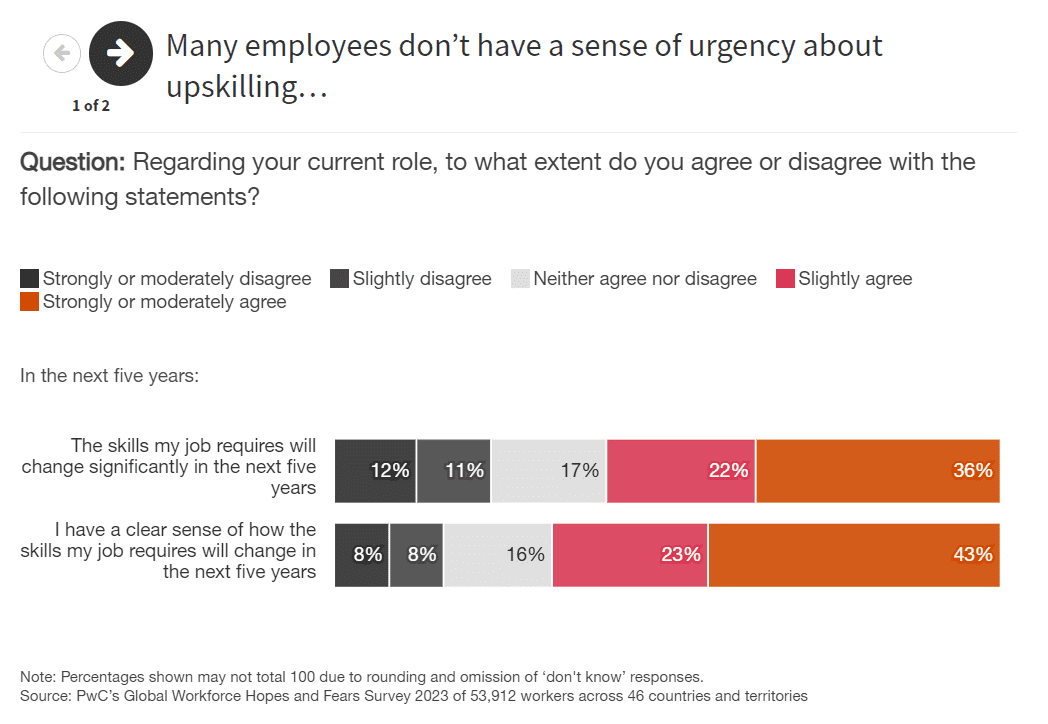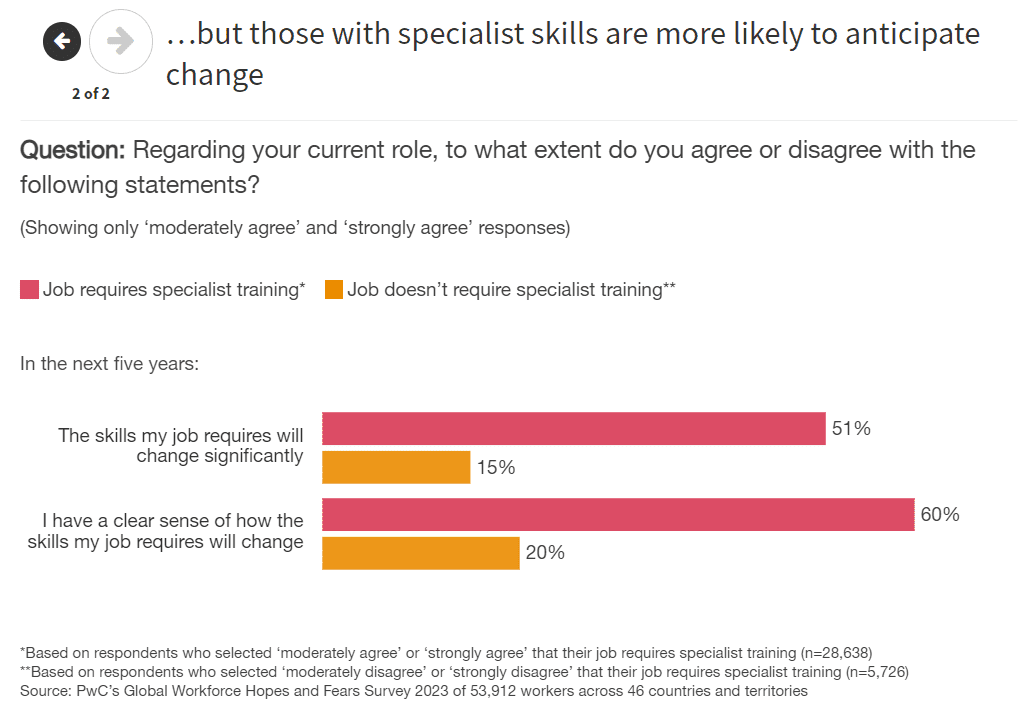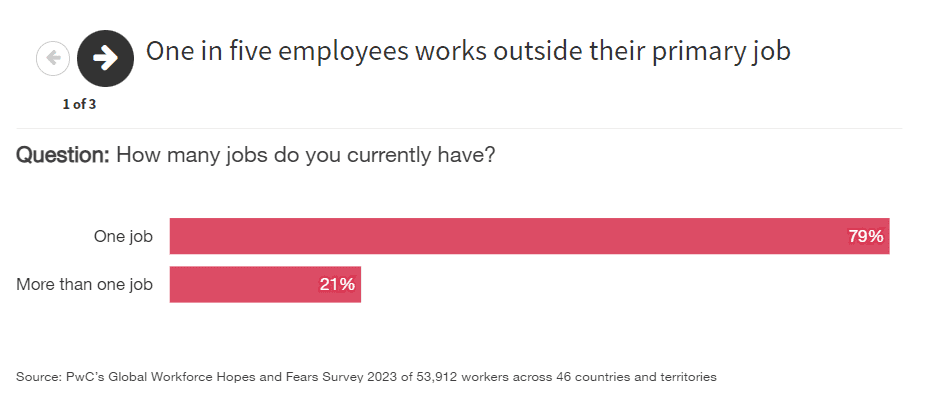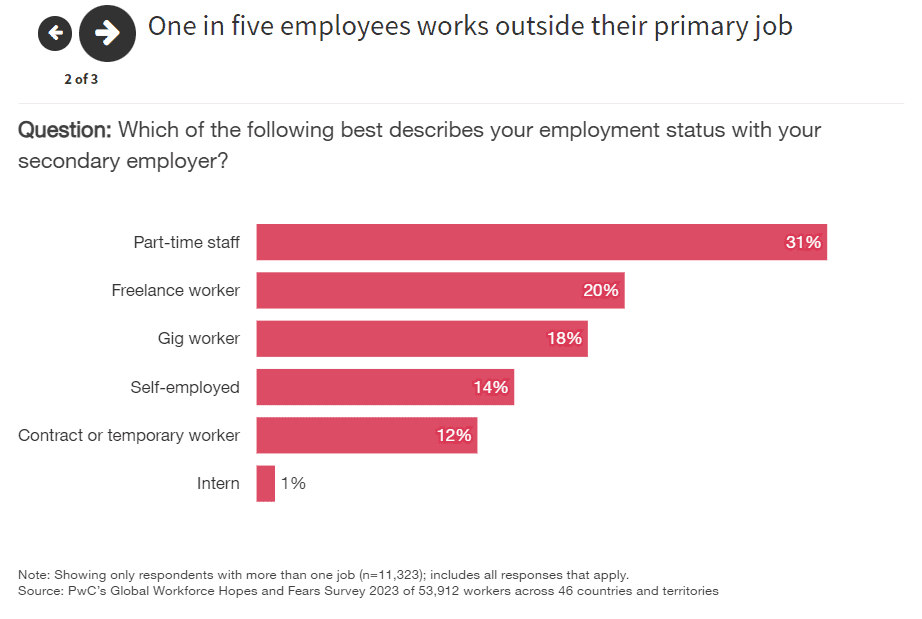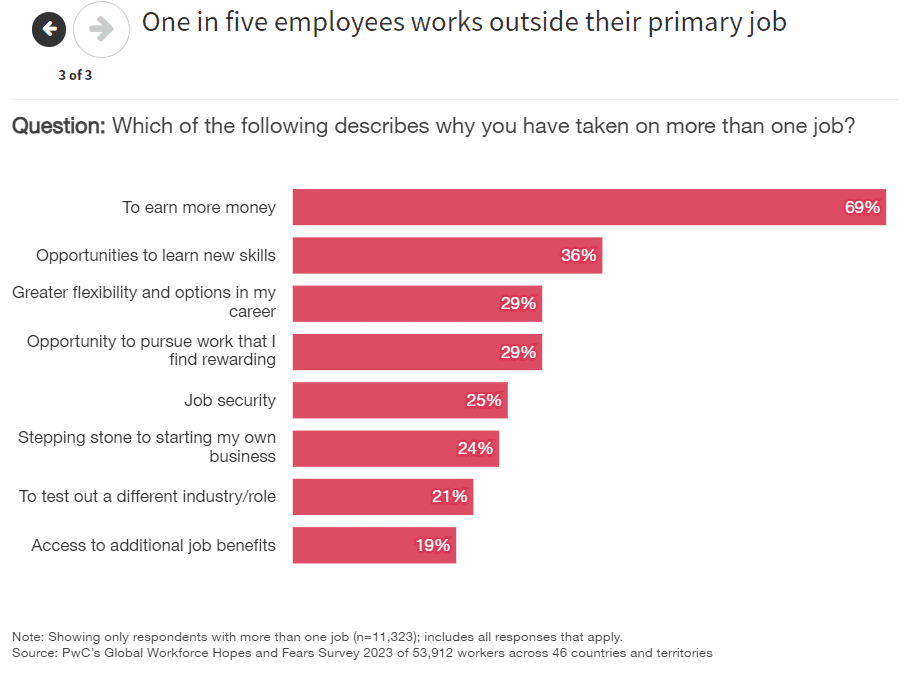Business leaders everywhere are prioritising transformation, but what if your most skilled people are more reinvention ready than your company culture is? And what if your employees say they are even more likely to quit now than they were last year—back when everyone thought the “great resignation” was at its peak?
This is the complicated—and unenviable—reality for many senior executives, as PwC’s latest Global Workforce Hopes and Fears Survey finds sizeable pockets of the global workforce eager to learn new skills, embrace artificial intelligence (AI) and tackle new challenges—even as many companies fail to tolerate debate and dissenting ideas, or even small-scale failures. Meanwhile, many workers are restless: fully 26% say they plan to quit their job in the next 12 months, up from 19% last year.
The survey, fourth in a series that dates to 2019, drew responses from nearly 54,000 workers in 46 countries and territories, and underscores the central challenge facing CEOs and other C-suite leaders: you have to reinvent your organisation, but without the support and energy of all your people, these efforts will fail. And in the current environment—where skills gaps appear to be widening and more employees than ever struggle financially just to get by—you can’t take anything about your workforce, or culture, for granted.
With that challenge in mind, we’ve organised this year’s survey summary into four actions that CEOs and other senior executives can prioritise to better understand what their employees want, learn what’s holding them back and—together with their people—make their organisations more reinvention ready.
This year's key findings
- Transform or die: One-third of workers say their company won’t be economically viable in ten years’ time if it continues on its current course—comparable to the 39% of CEOs who said this earlier in 2023 in PwC’s 26th Annual Global CEO Survey. Notably, gen Z workers are the most pessimistic: 49% say their company won’t survive another decade without change.
- Employees are restless: Despite recessionary worries and rising unemployment in some regions, 26% of all respondents say they are likely to change jobs in the next 12 months (up from 19% in our 2022 survey). The number is higher for younger employees, with 35% of gen Z and 31% of millennial respondents planning to change jobs.
- Financial hardships increase: 14% of employees around the world struggle to pay bills every month, and another 42% say once they cover their expenses, they have little or nothing left over (up from 37% in 2022). One in five respondents says they have an extra job, in addition to their principal one.
- Skills inequity on the rise: 53% of employees say that their job requires specialist training, up from 49% last year. Workers without specialist training are also more likely to be facing financial difficulties than specialist workers, and are less likely to have a clear sense of how their skills will change—all of which could further income inequality.
- Workers aren’t afraid of AI: Despite the prospect of AI-fuelled job losses, respondents cite the positive impacts of AI more frequently than they do the negative ones. The most common sentiment, expressed by 31% of respondents, is ‘AI will help me increase my productivity/efficiency at work.’
1. Engage and Inspire Your People—Especially Those Lagging Behind
Most business leaders take the dynamism and disruption of work and skills as a given. Indeed, according to the World Economic Forum, employers estimate that 44% of workers’ skills will be disrupted in the next five years.
Yet employees in our survey appear to see things differently. Just 36% of respondents as a whole strongly or moderately agree that the skills needed to succeed in their job will change significantly over the next five years, and only 43% say they have a clear sense of how the skills required for their job will change at all over that span.
It’s worrying that the majority of workers do not appear to have clarity on how their job requirements may change. If employees don’t anticipate or understand this, they may not be adequately prepared to acquire the new skills necessary to remain relevant and effective in their roles. But a closer look at the data reveals an even deeper concern: workers whose jobs don’t require specialised training appear the least likely to see change coming. Only 15% of these respondents say the skills required to do their jobs will change in the next five years, compared with 51% of their counterparts whose jobs are more specialised. This could leave workers who lack specialised training particularly vulnerable to job losses as skills continue to evolve, and as companies augment (or replace) jobs with automation, AI, or both.
By contrast, those with specialist training—a global cohort that grew by four percentage points since last year’s survey (53% of all workers versus 49% last year)—appear better prepared. Fully 60% of workers with specialist training say they have a clear sense of how the skills required to do their job will change in the next five years, compared with only 20% of those whose jobs don’t require specialised training (see chart below).
Finally, the survey identifies a “specialisation gap” when it comes to workers’ actions and attitudes with respect to advancing their skills and careers. In terms of actions, respondents with specialist training are about 1.5 times more likely than non-specialist peers to say they plan to ask for a raise or a promotion.
When it comes to employee attitudes, the survey found people without specialist training are far less likely to say that crucial soft (or human) skills—including adaptability and flexibility, critical thinking, and collaboration—will be important to their career in the coming five years (see chart below). These views differ sharply from those of employers in the World Economic Forum research, which noted the increased importance of complex problem-solving skills in the workplace, as well as the rising importance of resilience, flexibility and agility.
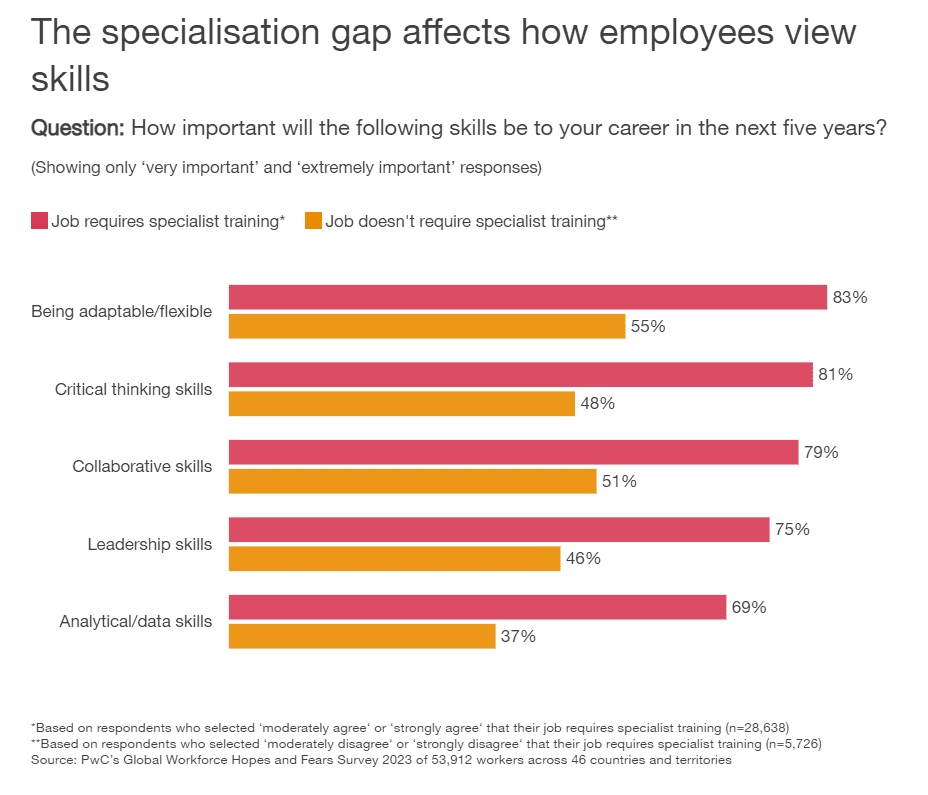
The divide between those who have and those who lack specialist skills is a growing problem, increasing the risk of economic inequality. Employees who are slow to prioritise and learn new skills will struggle to adapt. And widening skills gaps will almost certainly hinder productivity and innovation for companies, while exacerbating the stark economic disparities that already plague much of the world (see ‘Understand how the cost-of-living crisis is sapping your people’ below for more about the broader economic challenges our survey found). For CEOs and other senior executives, the way forward requires engaging—and inspiring—their employees.
Questions leaders must answer:
- Do we have the skills necessary to transform? Employees can be forgiven for not having a clear view of their future skills requirements. Employers can’t. Every leadership team should be able to draw a direct line from the capabilities they need to grow and innovate to the specific business outcomes they want to achieve, including transformation. But this isn’t a static exercise. Leaders must also be prepared to adjust the plan—repeatedly—as the environment changes. And through all this, they have to communicate consistently what these factors mean for their people, in order to harness their energy and avoid surprises. C-suite leaders have a responsibility to help create a more equitable future by giving everyone in the organisation equal opportunities to upskill and reskill—and provide a clear path forward.
- Are we creating an inclusive and inspiring vision? Successful leaders recognise that their transformation plans depend on employees who can translate their vision into action. But that can happen only if employees understand how the company is changing and what it means to them. Senior executives can help create a sense of urgency around upskilling with better clarity and transparency. But they can’t forget inspiration. When people feel excited and motivated about what lies ahead, they’re far more likely to embrace change. As a leader, you must create a narrative around your vision for the future of your organisation, and align it with the company’s purpose and mission. Encourage employees to ask questions and get involved, which helps create ownership and inclusion.
Do you have talent hiding in plain sight?
Successful leaders know that the currency of human capital isn’t jobs or roles, but skills. And although forward-looking companies are redesigning career paths around skills, many other organisations aren’t—often because of the perceived risks involved, or the inability to look beyond traditional talent pools and the hunt for the “perfect” candidate. Our survey suggests these companies are misguided.
For one thing, companies may not recognise the skills their employees already have. Among employees in our survey, 35% say they have skills that aren’t clear from their qualifications, job history or job titles; and 27% say that employers focus too much on job histories and not enough on skills. And 30% say that they have missed out on opportunities because they don’t know the right people (see chart below). All these findings suggest companies could do more to understand the skills they already have on their payroll.
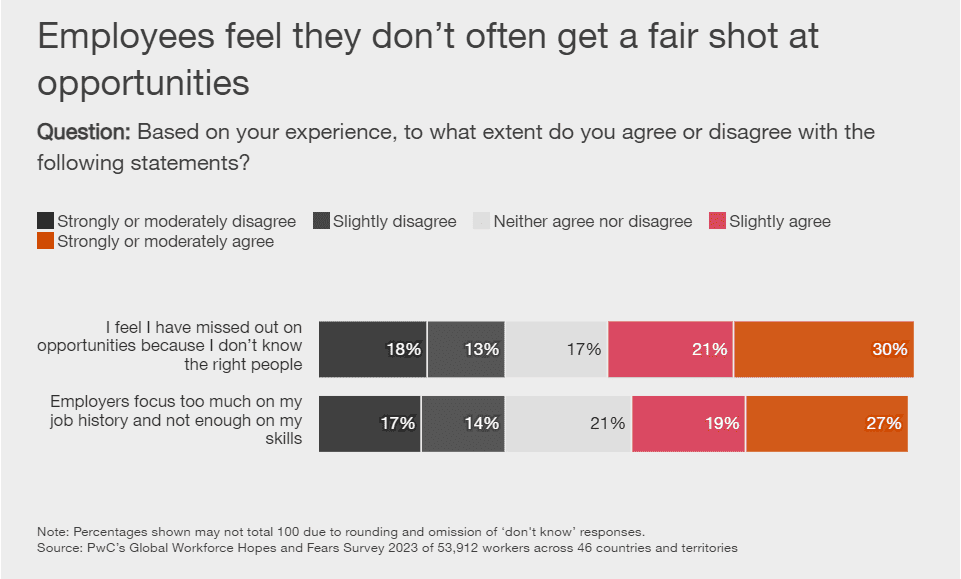
Moving beyond a qualifications-led approach would help workers by removing barriers to their ability to apply their skills and contribute, while helping companies make better use of their existing talent. What’s more, it would help companies more effectively tap into talent wherever it resides—for example, with contingent workers, retirees or other non-traditional labour pools. Scaling up a skills-first approach would have societal benefits as well: a recent study published by the World Economic Forum in collaboration with PwC found that more than 100 million people across 18 global economies would benefit directly from a skills-first approach.
2. Make Your Culture A Catalyst for Change
Most leaders recognise that their people are the company’s best source of energy, ideas and innovation. Yet our findings suggest that many companies discourage people from experimenting, debating ideas or disagreeing with the status quo—critical actions for innovation and employee engagement, not to mention corporate reinvention. And the problem is far worse than CEOs think.
For example, only 35% of respondents in our survey say that their manager tolerates small-scale failures, and just 33% say their manager encourages dissent and debate (see chart below)—much smaller proportions than what CEOs themselves reported in PwC’s 26th Annual Global CEO Survey.1
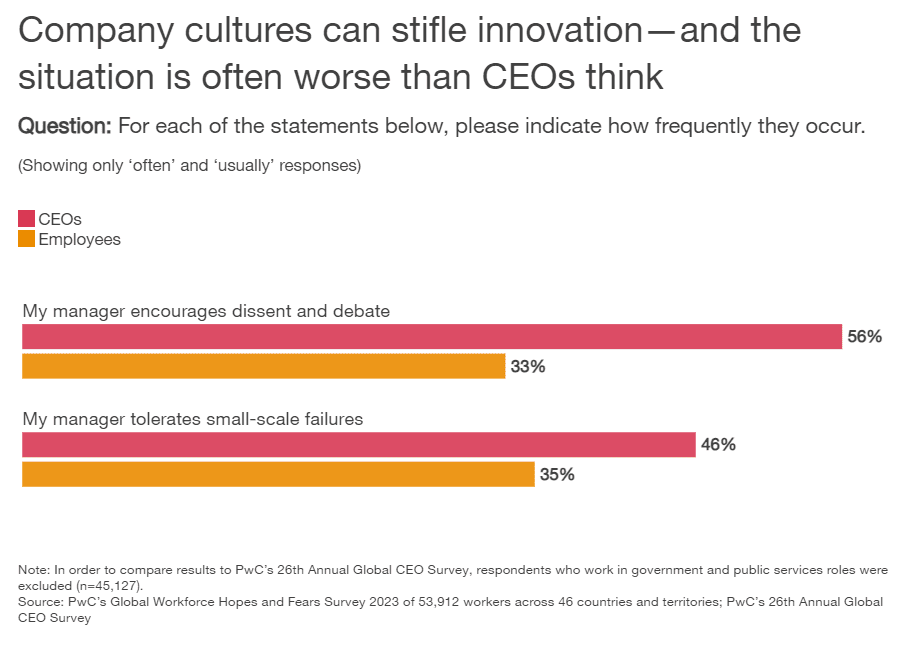
These aren’t the only obstacles. Only about half of respondents strongly or moderately agree that they bring new, innovative ideas to their team (52%), actively seek feedback (50%) or provide it to co-workers (49%), or step up to take on extra responsibilities (50%).
Moreover, only about half of all employees find their jobs fulfilling or say they can truly be themselves at work, findings that are comparable to those of last year’s survey. Notably, those who say they’re likely to change jobs in the next 12 months are also less likely to say they find their work fulfilling or that they can be themselves at work—suggesting that those factors play a key role in driving people to switch companies.
Meanwhile, more than one-fifth of workers report their workload was frequently unmanageable in the past 12 months, with half of those individuals citing a lack of resources as the primary driver. That supports other findings showing that burnout remains a problem.
Questions leaders must answer:
- Am I part of the problem? If you want creativity and innovation, your employees must feel safe to test and learn—and even fail—without fear of reprisal. Do they? If you came up in an era of clear expectations and command-and-control structures, encouraging your people to take risks and attack problems in unconventional ways may not feel natural to you. Start fostering these conditions by clarifying the line between the small failures that are part of any project and the big ones that can be avoided only if leaders put the right guard rails in place. And be sure to model the actions you want to see. Do you provide air cover for your team? Do you try new things (and take risks) in your own work, and talk openly with your team when you fall short? If not—it’s time to start.
- Is our culture causing some employees to disconnect? Your company culture may look very different from the C-suite than it does from the front line, and you can’t fix what you don’t see. Taking an inventory of your business culture will help you understand how your culture is unique, in part by clarifying what traits people identify when they describe it and the behaviours people habitually follow. But be sure to take a multi-pronged approach. Quick-hit pulse surveys can alert you to problems, as can focus groups with employees at all levels that help probe the pulse survey results and identify solutions. But don’t just listen inside your organisation. Social listening and online monitoring of employee review websites and social media platforms can highlight culture problems that employees aren’t sharing directly with you.
3. Understand How the Cost-of-Living Crisis is Sapping Your People
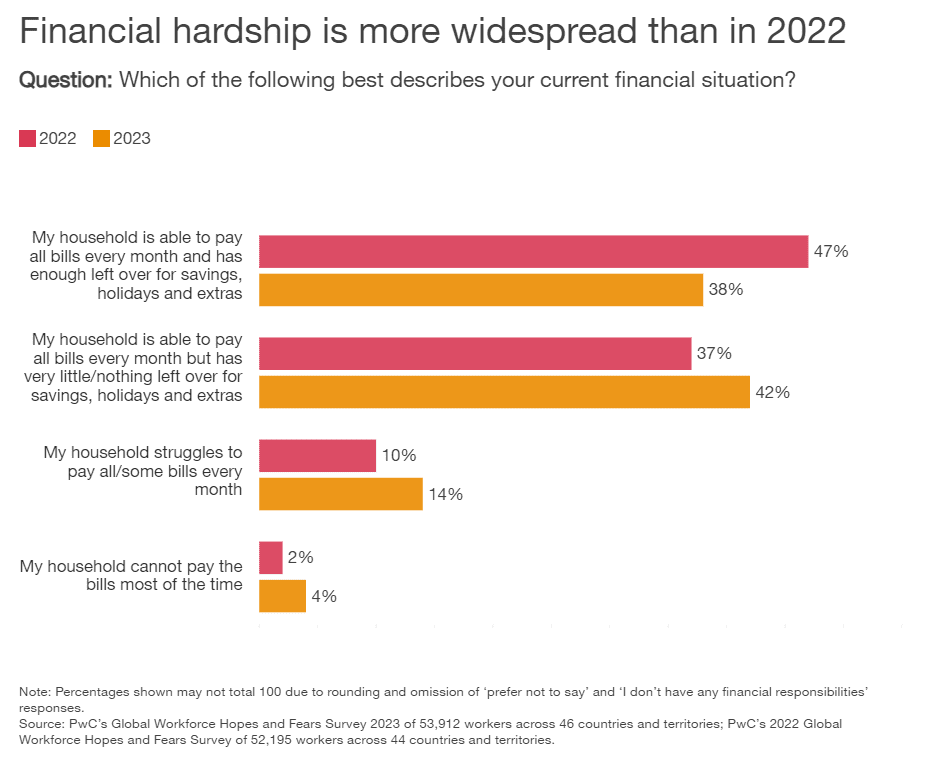
Our survey found struggling workers evenly spread across most demographic categories, though the economic burden falls somewhat more heavily on ethnic minorities than on others. Likewise, employees without specialised training were more likely to be struggling to pay their bills (17%), compared with 11% of respondents who had specialised skills.
Financial stress is debilitating for workers, and ultimately companies, too. Recent PwC research into the financial wellness of employees showed that economic stress—in addition to harming people’s emotional and physical well-being—hurts their productivity and engagement. The research also found that financially stressed employees were nearly five times as likely to say that personal finance issues have been a distraction at work.
These detrimental effects may worsen as employees take on second jobs. Twenty-one percent of workers in our survey report working multiple jobs (see chart below)—a proportion that’s higher still for people who struggle each month to pay the bills (24%) or cannot pay them most of the time (27%).
Financial pressure and the need to seek higher wages are surely factors in respondents’ increased willingness to look for a new job. Despite today’s economic uncertainty, a higher percentage of employees say they plan to change jobs in the next 12 months than said so last year (26% versus 19%). And although many people with second jobs cite the opportunity to learn new skills as one reason (36%), they are nearly twice as likely to cite the need to earn more money (69%).
Our survey also found an intriguing relationship between financial stress and employee focus on upskilling. Although 62% of those who can comfortably pay the bills say they actively seek out new opportunities to learn new skills, the proportion falls to 50% for those who struggle to pay the bills, or cannot make ends meet most of the time. It’s impossible to know, of course, which way the causation runs, but that’s beside the point. Leaders need to be aware of the stress their employees are under—including financial stress—and recognise that some of their people may be struggling just to get by. Helping employees address their financial stress will benefit workers, while also giving organisations the human energy and attention they need to thrive.
Questions leaders must answer:
- Do our compensation and talent strategies support one another? The financial burdens employees are facing put pressure on companies to consider baseline or cost-of-living salary increases. In addition, it’s never a bad time to make sure you’re offering competitive compensation packages to attract new candidates—and that you’re not losing your best people to higher-paying competitors. Finally, explore benefit packages that allow employees to customise their benefits to better meet their individual needs—which can provide more value and security to employees while potentially curbing costs for employers.
- Are we addressing financial wellness at work? Just as the covid-19 pandemic prompted many companies to talk openly about mental health, today’s economic challenges signal it’s time to focus on financial health. Consider creating employee assistance programmes that offer confidential counselling, including debt and financial coaching, and make sure employees know it’s OK to speak up about financial challenges at work and to ask for help. Granted, inflation and other economic factors are beyond the control of any single company, but leaders can still play a role by helping employees improve their financial literacy and manage financial stress.
4. Nurture Employee Interest in AI
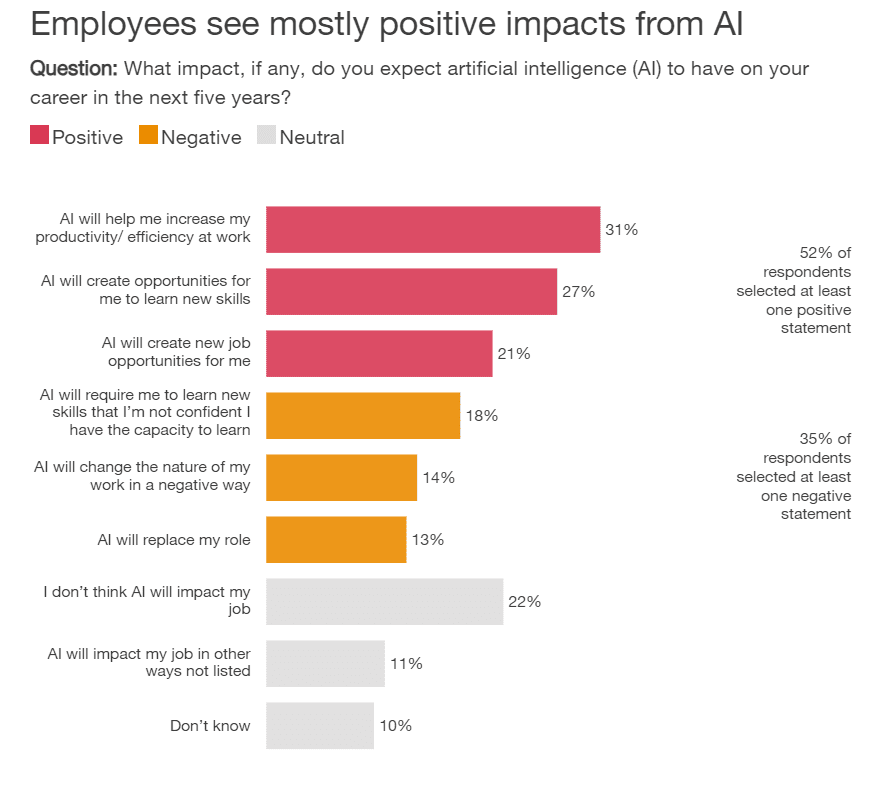
This is another area in which employees’ skills appear to colour their views. Those with specialised training are more likely to see AI impacting their career—in both positive and negative ways. However, those without specialised training are less likely to anticipate an impact from the technology and are more likely to be among the 22% of global respondents who say they don’t think AI will impact their job at all.
This finding is yet more evidence of the need to prioritise the development of human skills across your entire workforce, but particularly for workers whose jobs don’t require specialised skills. Human skills can’t be replaced by an algorithm, and they equip people to adapt to any new technology as it emerges.
Questions leaders must answer:
- Do we have a “future of work” narrative? The C-suite should set the organisation’s tone in regards to AI and other disruptive technologies. Create and communicate a strong narrative that covers what the future of work means for your company and people. Being transparent and purpose-driven regarding plans and decisions can also help employees who are wary of AI—and what it may mean for their jobs—feel more comfortable experimenting with it and even adopting it into their work where appropriate. At the same time, double down on helping your employees strengthen the human skills that AI can’t replicate, such as adaptability and flexibility, collaboration, and leadership.
- Are we empowering our people to influence our AI plans? Chances are your employees are already experimenting with AI outside work, so channel that energy by bringing them into brainstorming sessions to see how AI could improve things for their roles or departments. As the ones who are closest to the day-to-day work, they’ll have valuable insights into where AI might be most effective. And by seeking their input and involving them where possible in decision-making processes, you’ll be making changes with them—not for them—making it more likely that they’ll buy into the changes and become advocates among their peers. At the same time, create opportunities for employees to responsibly experiment and explore with AI in their work, with the right guard rails around data access and privacy, copyright protection and other sensitive areas.
The article was first published here.
Photo by Annie Spratt on Unsplash.

 1.0
1.0 




